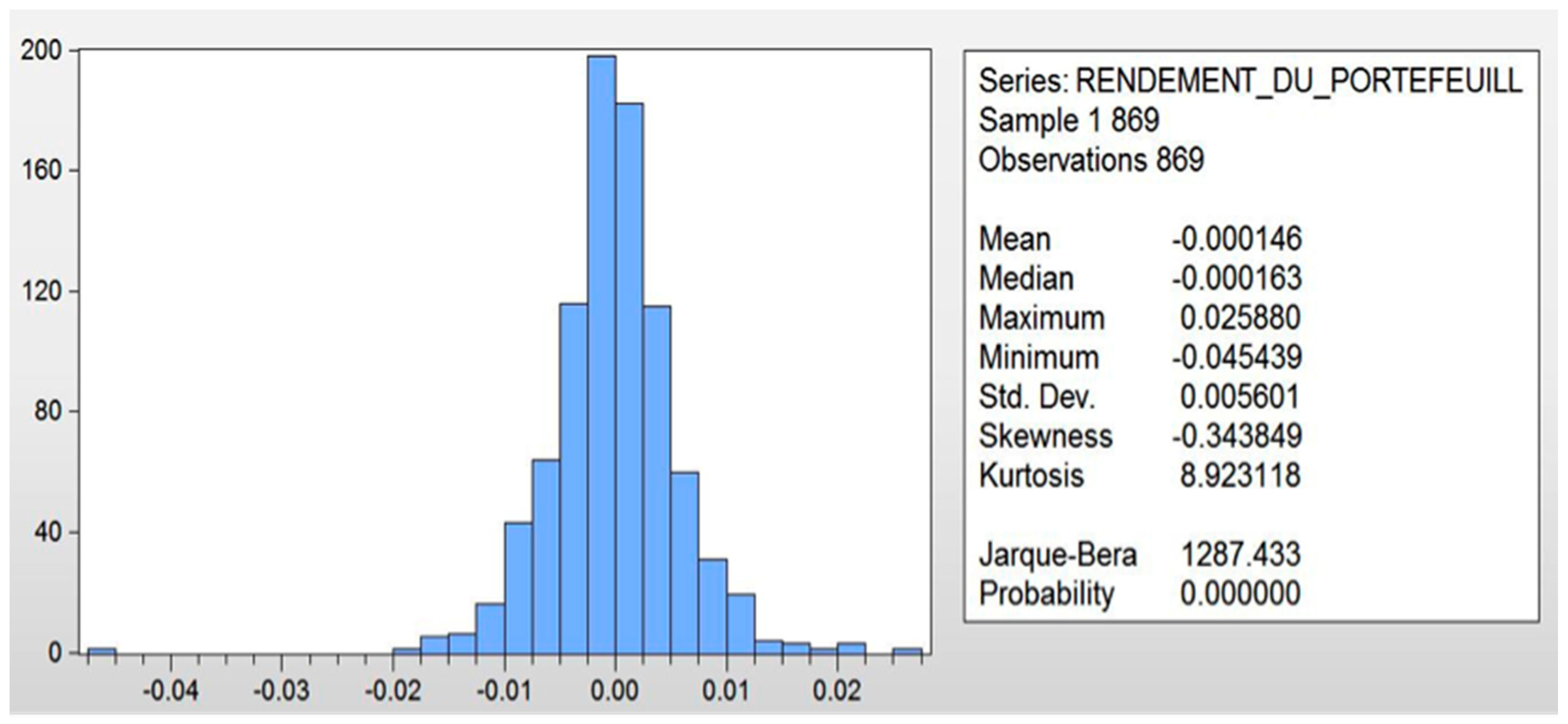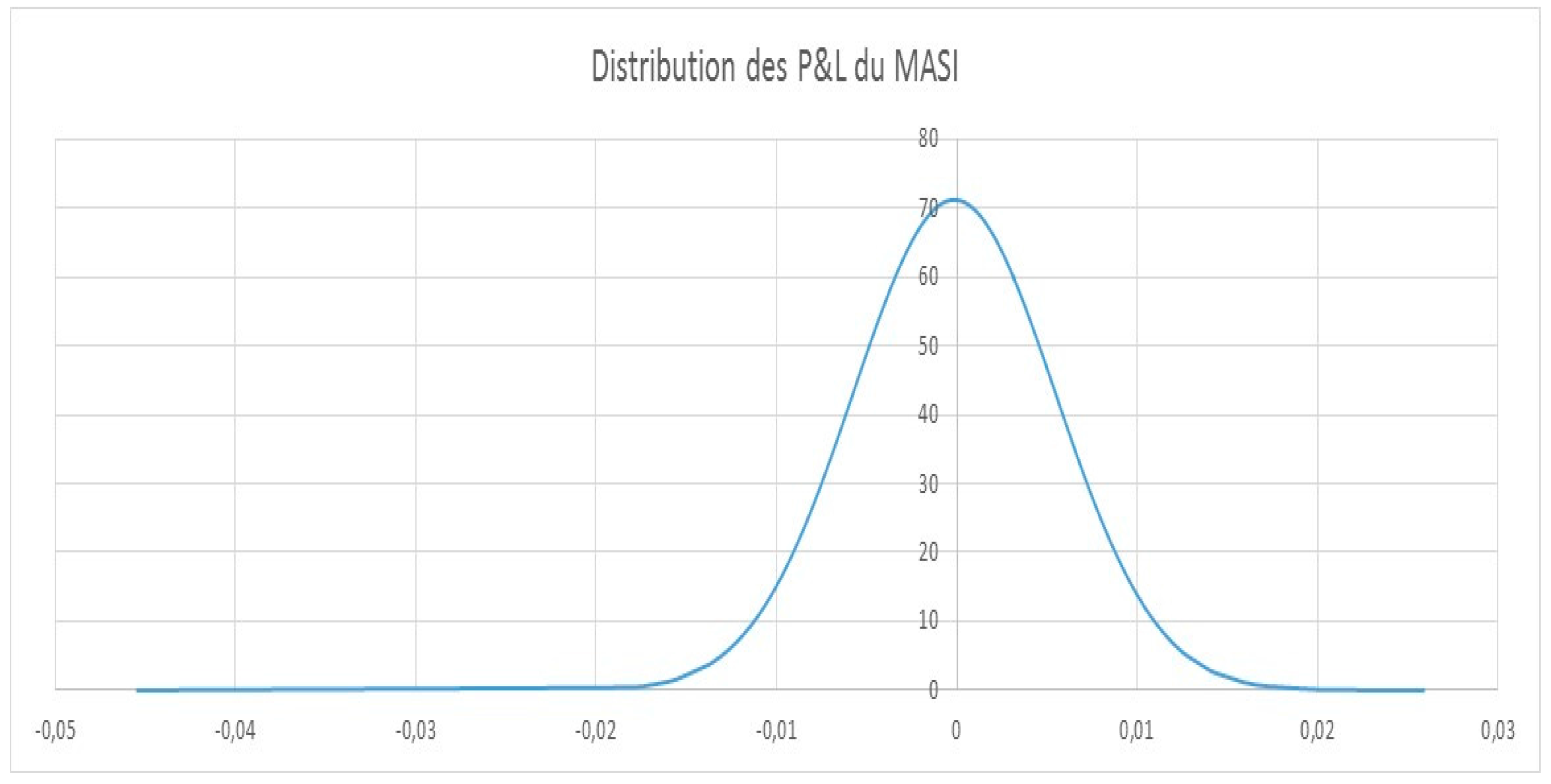In the case of VaR, the analysis of all these characteristics makes it possible to assert that it does not verify the axiom of subadditivity, which is a very important property on which the principle of diversification is based. The VaR of each individual security does not take into account the correlation effect between the securities, which is one of the most important principles for reducing risk.
2.3.1. Subadditivity Remedied by PVaR
The principle of diversification is one of the most important phenomena in modern finance. It allows risk reduction based on the correlation effect between securities. In principle, financial securities do not all move in the same direction at any given time; some of them move in a positive direction and others move in the opposite direction, which is why a portfolio composed of securities with different correlations allows for the easing of shocks linked to price fluctuations [
7].
However, we are intrigued by a question: if the diversification principle cannot be applied to VaR, why would the investor adopt it as a substitute for other measures?
Based on Euler’s theorem, a decomposition method will be proposed for VaR in order to define the portion of the VaR of the portfolio allocated to each asset, so that the overall VaR of the portfolio will be less than or equal to the sum of the VaR of each security in the portfolio [
8].
The VaR of each security in this case is called the Partial VaR, denoted PVaR. It is defined by the following formula:
where
VaR is then the sum of the N-many PVaRs.
Demonstration of the PVaR: To try to extract the formula of the PVaR, we will refer to Euler’s law (or Euler’s theorem).
Theorem 1. A function of several variables f: ℝn → ℝm differentiable at any point is (positively) homogeneous of degree k if, and only if, the following equation, called the Euler identity, is verified: This theorem will be applied to the VaR of a portfolio in order to obtain the PVaR of each security. We will begin by stating that the value of the portfolio is where and is the weighting vector of the securities making up our portfolio.
Let
be the weighting vector of the assets making up the portfolio, and let
, respectively, be the volatility and VaR of the portfolio, which depend on the weight of the securities. All weightings in the portfolio will be multiplied by the same ratio
; that is, the new vector considered will be
, and the standard deviation and VaR of the portfolio will, respectively, be
and
. Since the standard deviation and VaR are two homogeneous risk measures, we can write
Thus, increasing the size of a portfolio by a positive k-factor simply multiplies the risk by the same k-factor.
Since the standard deviation and the VaR are two differentiable and homogeneous measures, we then proceed to the Euler theorem verification; for this, the two parts of each equation are differentiated beside k. This derivative provides an estimation of the effect of an increase in all the positions in our portfolio on the VaR and the standard deviation.
By deriving the left side of Equations (23) and (24), we get
In the same way, for VaR we have
To calculate the derivative on the left side of Equation (9), we will change the variable by putting
:
where
This explains why the effect of an increase in k on VaR is determined by the effect of on VaR and the effect of k on .
Thus, knowing that
and
for every
from 1 to
N, Equation (28) becomes
Applying the same logic, we will proceed to the decomposition of the standard deviation, giving
Partial N-derivatives or , respectively, can be interpreted as the effect of an increase of on the overall risk.
The
N terms
,
, are referred to as the “Risk Contribution” of position
i, and can be interpreted as a measure of the effect of changes in the percentages of weights
in the portfolio. For example, the weight change
to
is the percentage change of
, which is the change in the standard deviation of the portfolio resulting from the weight change given by
A key element of the risk contribution relationship is that the sum of these
N elements gives us an idea of the total risk. The calculation of the standard deviation derivative in relation to the
N weight is
Demonstration of Equation (34): According to the diversification theory supported by Markowitz, the variance of a portfolio composed of three securities is as follows:
The derivative of the standard deviation obtained in relation to the weight of each security is derived as follows:
The same procedure is applied for the derivative in relation to the weights as follows:
Knowing that
, we can write
where the numerator is the covariance between
and portfolio returns
. Thus, the contribution of each asset by multiplying the two sides of Equation (1) by
can be written as follows:
Knowing that
we obtain
In addition, we know that the sum of the weights
, so by construction we obtain
. This is exactly analogous to the result verified by Markowitz’s portfolio theory, which states that the market beta is equal to the weighted average of the betas of the securities that make up the market [
9]. So, as VaR is a measure that aggregates several other risk measures in its calculation as the standard deviation, we can write
The partial derivative and the risk contribution of the
N assets are as follows:
By multiplying both sides by
, we obtain
2.3.2. The Expected Tail Loss
The VaR, like all models, cannot perform at 100%. It has a certain number of limitations, the most important [
10] of which is its inability to estimate extreme values that have a very low probability of occurrence and which are rarely realized (stock market crashes, financial crisis, etc.). Although the percentage that VaR neglects in its calculation is very small (generally between 1% and 5% error), the number of bank splits and financial crises, and the accentuation of financial market fluctuations, have clearly demonstrated that these small percentages can hide major damage events, causing massive losses.
Considering the shortcomings of the VaR, it remains a less complete measure with regards to the quantification of risk in extreme cases since it does not verify the principle of diversification, and especially since it does not succeed in modeling the phenomena considered exceptional [
10].
Thus, other alternative or even complementary measures to VaR have been developed to remedy the deficiencies presented by VaR. These measures include the ETL, also known as the Expected Shortfall or Conditional VaR [
11], which is defined as the expectation of losses that exceed the VaR.
Let be a random variable representing the risk associated with a given portfolio, its distribution function, and its density function.
The VaR of a position calculated by the distribution function
for a given probability is denoted
and is calculated as follows:
The Conditional VaR, denoted
, is a risk measure defined as follows:
This equation highlights the relationship between the frequency of losses beyond the VaR (in the denominator) and the size of VaR losses (numerator) by taking into account the first-order moment of the distribution of losses exceeding the VaR.
Like VaR, the ETL also has three approaches to its calculation: historical, parametric, and Monte Carlo [
12].







